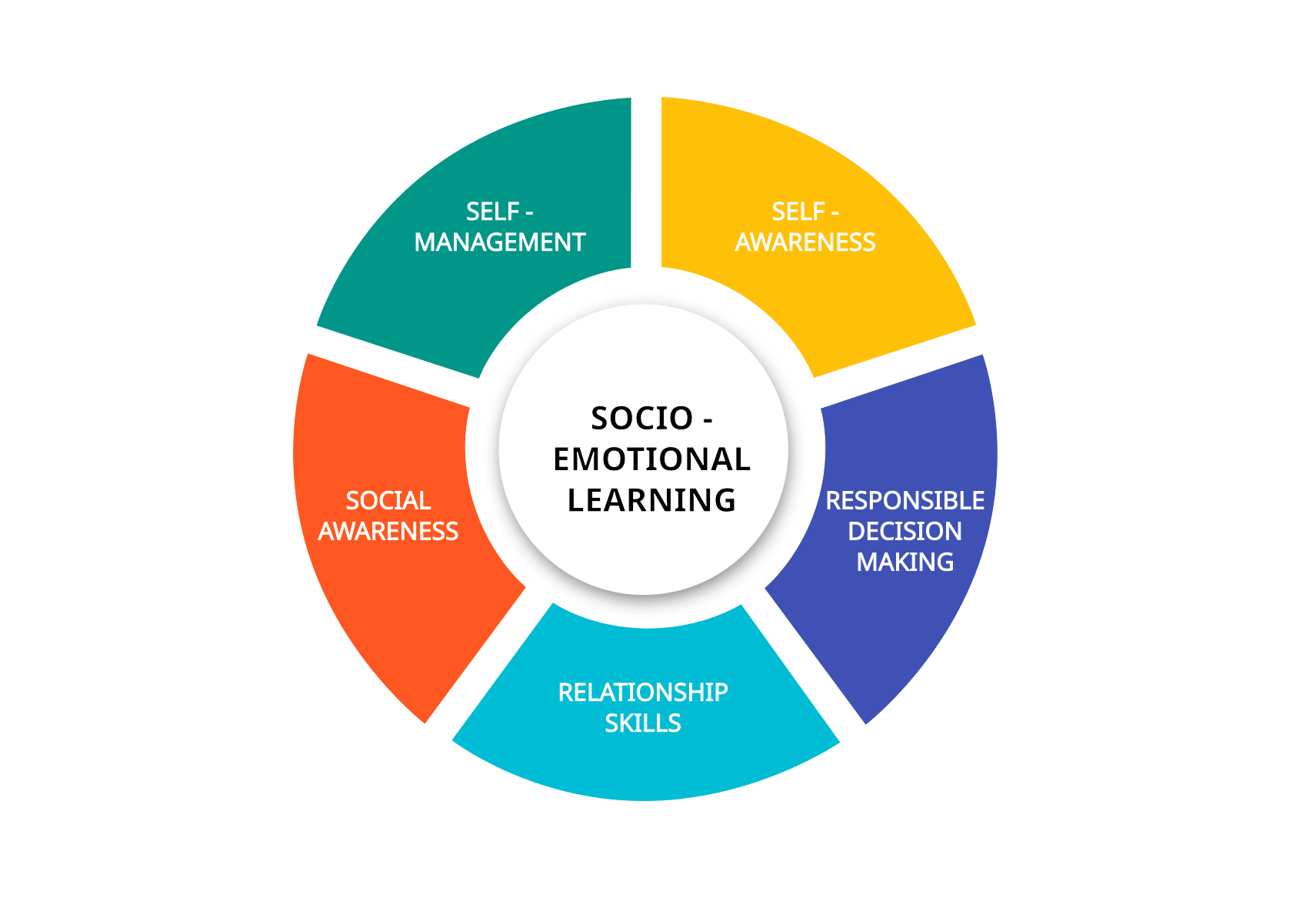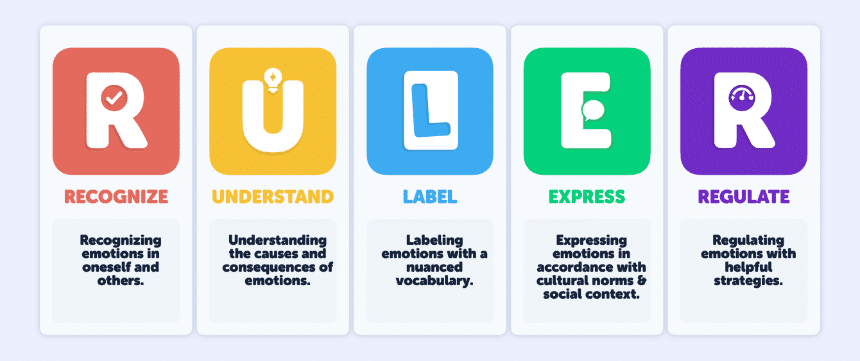What is Social-Emotional Learning (SEL)?

Social Emotional Learning (SEL) refers to how individuals, particularly students, acquire and apply the skills to manage emotions, set goals, show empathy for others, build positive relationships, and make responsible decisions. Every time you work through a disagreement with a friend or calm your nerves before a major presentation are some examples of applying social-emotional skills. SEL is commonly integrated into educational settings to promote personal and social growth alongside academic achievement. While we might think of school as a place to learn math, history, or science, SEL reminds us that emotional and social skills are just as important as academic ones.
💡 Lessons learnt: Intelligence is the ability to adapt to change.
On a social level, humans are wired to connect. Psychologists like Lev Vygotsky have long emphasized that learning is a social process. Children (and adults) learn best when they’re interacting with others, working together, and navigating social situations. SEL provides a structured way for students to develop such skills, helping them become more resilient, empathetic, and effective in personal and academic settings. According to a meta-analysis of over 200 studies, students who participated in SEL programs saw an 11 percentile-point gain in academic achievement compared to students who didn’t have SEL in their schools (Durlak et al., 2011).
The Five Key Areas of Social-Emotional Learning (SEL)
Social Emotional Learning (SEL) is broken down into five core areas that work together to support emotional intelligence, interpersonal skills, and overall well-being.
1. Self-awareness
Self-awareness involves understanding one's own emotions, thoughts, and values and how they influence behavior. It includes:
- Emotional recognition: Identifying emotions in oneself, such as happiness, frustration, or anxiety.
- Accurate self-perception: Recognizing strengths and weaknesses, and how these affect behavior and relationships.
- Confidence: Developing a sense of self-worth and the belief that one can achieve goals.
📚 Studies shows that greater self-awareness leads to improved emotional regulation and decision-making
2. Self-management
Self-management refers to the ability to control one's emotions, thoughts, and behaviors effectively in different situations. Key aspects include:
- Emotional regulation: Managing feelings of stress, anger, or excitement in a constructive way.
- Goal-setting: Establishing personal and academic goals and creating plans to achieve them.
- Impulse control: Resisting harmful or disruptive actions when emotionally provoked.
- Perseverance: Maintaining motivation and focus on tasks despite challenges or failures.
📚 Effective self-management has been found to lead to higher academic achievement and reduces behavioral issues.
3. Social awareness
Social awareness is the ability to understand and empathize with others, particularly from diverse backgrounds. This includes:
- Empathy: Recognizing and appreciating how others feel.
- Perspective-taking: Understanding others' points of view and emotions.
- Cultural competency: Recognizing societal and cultural influences on behavior and emotions, and respecting diversity.
- Service to others: Identifying ways to help and contribute to the well-being of others.
📚 Social awareness fosters inclusive environments and reduces social conflicts.
4. Relationship skills
Relationship skills are essential for forming and maintaining healthy and rewarding relationships. They include:
- Communication: Expressing thoughts and feelings clearly while listening to others.
- Teamwork: Cooperating and working effectively in groups, respecting differing perspectives.
- Conflict resolution: Managing disagreements constructively and reaching peaceful solutions.
- Seeking help: Knowing when and how to seek support from others when needed.
📚 Strong relationship skills contribute to positive social connections and reduce feelings of isolation or loneliness
5. Responsible decision-making
This component involves making ethical, constructive choices about personal and social behavior. It includes:
- Evaluating consequences: Considering short-term and long-term consequences of actions.
- Ethical standards: Acting in ways that are consistent with social norms and ethical values.
- Problem-solving: Identifying solutions to personal or social problems using critical thinking.
- Reflecting on actions: Learning from past experiences to make better future decisions.
📚 Individuals with strong decision-making skills tend to engage in fewer risky behaviors and experience improved life outcomes
SEL Frameworks: Bringing it All Together
SEL frameworks are structured models that outline the key competencies, practices, and approaches for implementing Social Emotional Learning (SEL) in educational and organizational settings. These frameworks provide a roadmap for how SEL can be integrated into curriculum design, teaching practices, school policies, and community engagement to foster emotional and social development.
Think of these frameworks as the blueprints for helping students build their social and emotional muscles, much like how a gym routine helps you build physical strength. There are a few well-known frameworks for SEL that schools and educators use to guide their programs:
CASEL Framework

The Collaborative for Academic, Social, and Emotional Learning (CASEL) is one of the most widely recognized models for SEL. Most schools that implement SEL follow this framework. It’s based on the five core competencies we just talked about—self-awareness, self-management, social awareness, relationship skills, and responsible decision-making.
The CASEL framework operates on two levels:
- Individual level: Focuses on helping students develop these competencies through lessons, activities, and real-life practice.
- School-wide level: Encourages creating a positive environment in the classroom, hallways, and even after-school programs. For example, teachers incorporate SEL into daily routines, like using group activities to promote teamwork or mindfulness exercises to help students focus before a test.
What’s great about CASEL is that it doesn’t just focus on students. It also emphasizes the importance of adult SEL, meaning teachers, staff, and parents should also develop these skills to model and support the students’ growth. After all, kids are more likely to pick up these skills if they see adults around them practicing the same behaviors.
The RULER Approach

Developed by Yale University’s Center for Emotional Intelligence, the RULER approach takes a deep dive into emotional literacy. RULER is an acronym that stands for:
- Recognizing emotions in oneself and others
- Understanding the causes and consequences of emotions
- Labeling emotions accurately
- Expressing emotions appropriately
- Regulating emotions effectively
The goal of the RULER approach is to help students—and adults—better understand their emotions and use this emotional awareness to navigate social situations. A key tool in this framework is the Mood Meter, a color-coded chart that helps students label how they’re feeling (e.g., red for angry or blue for sad) and then choose strategies to manage those emotions. The Mood Meter helps students identify their emotional state, and then the teacher can guide them in using self-management techniques if needed—like taking a deep breath or practicing positive self-talk before jumping into the lesson.
Second Step Program
The Second Step Program is a scripted curriculum that offers teachers ready-to-use lessons and activities to help students build SEL skills across different grade levels, from preschool through high school.
This program focuses on four key areas:
- Skills for Learning: Teaching kids how to focus, listen, and be assertive.
- Empathy: Helping kids recognize emotions in others and respond with kindness.
- Emotion Management: Equipping kids with strategies to calm themselves in stressful situations.
- Problem Solving: Encouraging kids to find solutions to interpersonal conflicts and challenges.
One thing that sets the Second Step Program apart is its emphasis on bullying prevention.

Adiutor
Adiutor means "helper" - we do just that, by taking a load of your school administration and helping you focus on what matters most: the kids.
References
- Belfield, C., Bowden, B., Klapp, A., Levin, H., Shand, R., & Zander, S. (2015). The economic value of social and emotional learning. Journal of Benefit-Cost Analysis.
- Collaborative for Academic, Social, and Emotional Learning (CASEL). (2020). CASEL’s SEL framework: What are the core competence areas and where are they promoted? CASEL.
- Durlak, J. A., Weissberg, R. P., Dymnicki, A. B., Taylor, R. D., & Schellinger, K. B. (2011). The impact of enhancing students’ social and emotional learning: A meta-analysis of school-based universal interventions. Child Development, 82(1), 405-432.
- Hawn Foundation. (2011). The MindUP program for success in school and life: A curriculum and guide for educators. Scholastic Teaching Resources.
- Jones, D. E., Greenberg, M., & Crowley, M. (2015). Early social-emotional functioning and public health: The relationship between kindergarten social competence and future wellness. American Journal of Public Health, 105(11), 2283-2290.
- Mahoney, J. L., Durlak, J. A., & Weissberg, R. P. (2018). An evidence-based framework for the impact of social and emotional learning on students. Educational Psychologist, 53(4), 239-255.
- Reyes, M. R., Brackett, M. A., Rivers, S. E., Elbertson, N. A., & Salovey, P. (2012). The interaction effects of program training, dosage, and implementation quality on targeted student outcomes for The RULER Approach to Social and Emotional Learning. School Psychology Review, 41(1), 82-99.
- Schonert-Reichl, K. A., & Weissberg, R. P. (2014). The case for promoting social and emotional learning in schools: A review of the evidence. Educational Psychologist, 49(2), 156-172.
